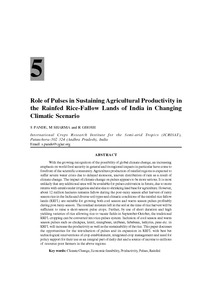Role of Pulses in Sustaining Agricultural Productivity in the Rainfed Rice-Fallow Lands of India in Changing Climatic Scenario
Abstract
With the growing recognition of the possibility of global climate change, an increasing emphasis on world food security in general and its regional impacts in particular have come to forefront of the scientific community. Agriculture production of rainfed regions is expected to suffer severe water crisis due to delayed monsoon, uneven distribution of rain as a result of climate change. The impact of climate change on pulses appears to be more serious. It is most unlikely that any additional area will be available for pulses cultivation in future, due to more returns with cereals under irrigation and also due to shrinking land base for agriculture. However, about 12 million hectares remains fallow during the post-rainy season after harvest of rainy season rice in the India and diverse soil types and climatic conditions of the rainfed rice fallow lands (RRFL) are suitable for growing both cool season and warm season pulses profitably during post rainy-season. The residual moisture left in the soil at the time of rice harvest will be sufficient to raise a short-season pulse crops. Further, by use of short duration and high yielding varieties of rice allowing rice to vacate fields in September-October, the traditional RRFL cropping can be converted into rice-pulses system. Inclusion of cool season and warm season pulses such as chickpea, lentil, mungbean, urdbean, fababean, lathyrus, peas etc. in RRFL will increase the productivity as well as the sustainability of the rice. This paper discusses the opportunities for the introduction of pulses and its expansion in RRFL with best bet technological interventions of crop establishment, integrated crop management and need for policy support for their use as an integral part of daily diet and a source of income to millions of resource poor farmers in the above regions

